LEGO therapy tax deduction can help offset the costs of using therapeutic toys for a wide range of conditions, including autism, ADHD, post-stroke recovery, and even stress therapy. In this post, you’ll find a step-by-step guide to claiming these expenses on your taxes in the U.S. and Canada, along with how to maximize insurance coverage and employer wellness benefits. We’ll also include real-life testimonials and expert resources to guide you through the process. Additionally, don’t forget to check out our FAQ section at the end of the post, which answers many common questions about tax deductions and insurance coverage for LEGO therapy.
My Personal Experience with LEGO Therapy: Overcoming Challenges and Maximizing Financial Benefits
Growing up with ADHD, raising children with autism, and recovering from a major stroke, I’ve faced many challenges throughout my life. But one thing has been constant—LEGO toys have played an incredibly important role in my therapeutic journey and my family’s well-being.
From early on, I realized that LEGO therapy wasn’t just a creative outlet for me, but a powerful tool for post-stroke recovery, stress relief, and childhood autism therapy. Building with LEGO helped me improve my fine motor skills, regain cognitive abilities, and reduce anxiety. Watching my children benefit from LEGO therapy for autism was a revelation; it became more than just a toy—it was a therapeutic solution that brought measurable progress in our lives.
Navigating Insurance and Tax Deductions
During difficult financial times, I learned the hard way how important it is to utilize every tool available, including tax deductions and insurance claims. Over the years, I’ve successfully claimed the costs of purchasing LEGO toys as therapy through both tax relief programs and our private work wellness benefits. These benefits allowed me to stretch our resources and provide the best possible support for my kids and myself.
Making claims to insurance companies can feel daunting at first, but having the right paperwork from therapists or doctors has been a crucial factor in getting these expenses covered. In some cases, I didn’t even need a doctor’s note—just the receipts were enough to submit for reimbursement through my employer’s wellness program.
Speak to Your Doctor: Get a Note for LEGO Toy Therapy
If you’re considering LEGO therapy as a tool for your child’s development or your own recovery, I encourage you to speak to your doctor. They’re here to support you and will often provide a note that specifies the use of a particular product like LEGO as part of your therapy plan. For example, if your child engages better with LEGO than other toys, a doctor’s note can validate this as a therapeutic tool for autism or ADHD therapy.
Maximizing Your Benefits
Stretching your dollars and using available insurance benefits can go a long way in providing therapeutic tools that might otherwise be out of reach. Many employer wellness programs offer reimbursements for health and wellness purchases, often without requiring a prescription. This can make LEGO sets and other therapeutic products more accessible, helping you or your family get the most out of therapy while keeping financial stress low.
By following these steps and being proactive, you can access the full benefits of LEGO therapy, just as my family has. Remember, it’s all about finding the right tools to enhance our well-being and using every available resource to make that possible.
Learn more about how LEGO therapy can aid post-stroke recovery by improving motor skills and cognitive function. How Can LEGO Therapy Help With Post Stroke Recovery?
<strong>LEGO Toy Therapy: A Fun Path to Growth and Your Tax Deduction
You might think LEGO toys are just a fun, colourful toy for kids, but did you know LEGO Toy therapy can also be a powerful therapeutic tool—and even qualify for a LEGO therapy tax deduction for autism? Those little bricks (and other similar toys) can do more than just build castles. Therapists have started using LEGO toys to help kids and adults alike, and it’s becoming a go-to for occupational and mental health therapy. Imagine putting together pieces to improve motor skills, boost attention, and even tackle anxiety—these therapeutic toys offer an impressive range of benefits and may qualify for tax deductions!
There’s solid research backing up the use of LEGO toys and bricks in therapy. The act of following instructions and creating something tangible helps individuals develop patience, problem-solving skills, and even social interaction abilities. For instance, kids on the autism spectrum often benefit greatly from LEGO therapy sessions. There are even LEGO-based social clubs designed to help children learn to communicate and collaborate with others.
Looking for ways to manage stress as an adult? Discover the impact of stress relief toys, including LEGO, on mental health. Can Stress Relief Toys for Adults Really Make a Difference in Your Daily Life?
Navigating the Rules: How to Claim LEGO Therapy as a Tax Deduction (U.S. and Canada)
Turning something fun like LEGO therapy into a tax deduction is a great opportunity, but it’s important to understand the rules for both U.S. and Canadian taxpayers.
U.S. Guidelines for LEGO Therapy Tax Deduction
In the U.S., the IRS allows for the deduction of certain medical expenses, and LEGO therapy can qualify—if you follow the guidelines. Here’s what you need to do to make your LEGO therapy expenses eligible for a tax deduction.
•What You Need:
•A prescription from a qualified therapist or doctor outlining LEGO therapy as a necessary treatment.
•Receipts for LEGO purchases used in therapy.
•A detailed treatment plan to support your case.
To claim these deductions and ensure you’re claiming LEGO therapy as a medical expense on taxes, you’ll need to itemize your medical expenses on Schedule A of Form 1040. For more on what counts as a deductible medical expense, visit the IRS Medical and Dental Expenses Publication 502.
For more information on how to deduct medical expenses for therapy, you can check out this detailed guide from TurboTax.
Canadian Guidelines for LEGO Toy Therapy Tax Deduction
In Canada, similar tax relief is available through the Medical Expense Tax Credit (METC), offering tax deductions for therapeutic toys like LEGO when prescribed by a licensed therapist. This may be claimed as part of your medical expenses.
•What You Need:
•A prescription from a licensed healthcare professional.
•Detailed records of LEGO purchases and receipts.
•Supporting documentation showing how LEGO therapy is part of a structured therapeutic plan.
Canadian taxpayers can claim these expenses on Line 33099 or 33199 of their tax return. For more details, check out the CRA’s guide to eligible medical expenses.
For Canadian readers, you can also explore this CRA resource on claiming medical expenses.
LEGO Therapy Tax Deduction and Insurance Coverage: What You Need to Know
In addition to claiming a LEGO Toy therapy tax deduction, you may also be able to get coverage for LEGO Toy therapy under your insurance plan. Here’s what you need to know about navigating both tax and insurance benefits.
Insurance Coverage for LEGO Toy Therapy as a Medical Expense
In both the U.S. and Canada, health insurance plans may cover LEGO Toy therapy under categories such as Durable Medical Equipment (DME) or therapeutic tools, but can LEGO therapy be claimed on insurance? It depends on your specific policy. Be sure to review your policy and confirm if this expense is eligible for reimbursement.
For more information on how to submit insurance claims for medical expenses like LEGO Toy therapy, you can refer to this article from HealthCare.gov.
This article explains how to make the most of your insurance coverage, including submitting claims for medical expenses, which can include therapy tools like LEGO Toys, if categorized under Durable Medical Equipment (DME). It also provides tips on maximizing insurance coverage for LEGO therapy and how to navigate your insurance plan to ensure that therapy expenses are reimbursed.
Curious about using LEGO to help kids with ADHD focus and develop essential skills? Find out how LEGO therapy works for ADHD. Can LEGO for ADHD Help Kids Focus and Thrive? Discover the Surprising Benefits
Real Success Stories: How Families Have Claimed Tax Deductions and Insurance for LEGO Therapy
Here are some real-world examples of families and individuals who have successfully claimed LEGO therapy and other therapeutic toys as tax deductions or insurance-covered expenses:
1. Medical Expense Deduction Success (U.S.):
A comprehensive guide on TurboTax explains how medical expenses exceeding 7.5% of adjusted gross income (AGI) are deductible. This includes therapeutic tools like LEGO Toys if prescribed by a healthcare professional. Families who have used LEGO Toys for autism or occupational therapy have deducted these costs under Schedule A of Form 1040 by providing the necessary medical documentation.
• “If your medical expenses surpass 7.5% of your AGI, you can deduct qualifying expenses, including therapy tools prescribed by your healthcare provider. This has helped families claim deductions for therapeutic toys.”
2. Insurance Coverage for LEGO Toy Therapy as a Medical Expense:
In both the U.S. and Canada, health insurance plans may cover LEGO therapy under categories such as Durable Medical Equipment (DME) or therapeutic tools. Be sure to review your policy and confirm if this expense is eligible for reimbursement. Source: Sioux falls counselling
“Play therapy is a form of psychotherapy and is billed as such to health insurance plans. If your health insurance has coverage for mental or behavioral health services, then play therapy is included in that coverage.
Parents of children with autism can benefit greatly from LEGO therapy. Discover how LEGO can unlock new worlds for your child in this comprehensive guide. Autism Guide for Parents: Can LEGO Unlock New Worlds for Your Child?
Guide: How to Maximize Your LEGO Therapy Tax Deduction
If you’re ready to claim LEGO therapy as a tax deduction, here’s what you need to do:
1. Get a Prescription:
Make sure LEGO therapy is part of a prescribed treatment plan by a licensed therapist or doctor.
2. Keep Detailed Records:
Track receipts for LEGO purchases and file notes from the therapist that support the therapeutic goals of LEGO.
3. File for Tax Deductions:
•U.S.: Use Schedule A of Form 1040 to itemize your LEGO therapy expenses.
•Canada: Claim your expenses on Line 33099 or Line 33199 using the CRA’s guidelines.
Take Advantage of LEGO Therapy as a Tax Deduction
Using LEGO therapy not only offers powerful therapeutic benefits but can also serve as a tax deduction for those with the proper documentation. By following the steps outlined above and ensuring you have the right paperwork, you can take advantage of potential savings while continuing to help improve motor skills, cognitive function, and emotional well-being through LEGO Toy based therapy.
Leveraging Employer Wellness Benefits for LEGO Toy Therapy
Many LEGO fans, including adult fans of LEGO and kids who love LEGO, may be unaware that their employer’s wellness benefits can cover therapeutic tools like LEGO therapy. These programs, often referred to as Wellness Spending Accounts (WSA) or Lifestyle Spending Accounts (LSA), allow employees to claim health-related expenses without requiring a doctor’s note.
Using Wellness Accounts for LEGO Therapy
For those who find LEGO more than just a toy, learning how to use wellness benefits for LEGO Toy therapy can make it easier to claim reimbursement through employer-sponsored benefits.
Many employer-sponsored benefits provide yearly allowances (often $200 or more) that employees can use to cover expenses for therapeutic products like LEGO Toys, fitness equipment, or wellness services. All you usually need is a receipt for the item or service to claim reimbursement.
Accessible to Kids and Adults Who Benefit from LEGO Toys
This can be a great financial resource for adults using LEGO Toys as a tool for mental health and for parents whose children are using LEGO Toy therapy as part of their development. Whether you’re looking to reduce stress, improve motor skills, or use LEGO Toys as a therapeutic tool for conditions like autism or ADHD, it’s worth checking if your employer offers this type of benefit.
No Doctor’s Note Required: Just Submit a Receipt
Best of all, most programs allow employees to submit receipts without needing a doctor’s prescription. This makes it simple for LEGO enthusiasts to claim LEGO Toy sets or therapy tools under their wellness benefits, especially for those who find LEGO Toy therapy effective for managing stress or improving cognitive skills.
How to Check If You Qualify
If you’re unsure whether your employer offers a wellness spending account or lifestyle benefits, review your benefits plan or contact your HR department. It’s a fantastic way to offset the cost of tools like LEGO, especially for adult fans of LEGO who are incorporating it into their daily routines for stress relief or cognitive stimulation.
For more information on how employers are offering wellness benefits to support employees’ mental and physical health, visit Olympia Benefits or explore the Canada Life’s wellness and lifestyle accounts options at Canada Life.
To learn more about how employers are maximizing wellness benefits for their employees, including what types of expenses can be covered, check out this resource from Olympia Benefits and this page on Canada Life’s wellness and lifestyle accounts.
Frequently Asked Questions: LEGO Therapy Tax Deductions and Insurance Coverage
1. Can I claim LEGO sets as a medical expense for therapy on my taxes?
Answer: Yes, you can claim LEGO therapy sets as a medical expense if prescribed by a licensed therapist or doctor as part of a structured treatment plan. This can be applied to conditions such as autism, ADHD, and post-stroke recovery. Make sure you retain the proper receipts, documentation, and a formal prescription to claim these medical tax deductions.
2. Do health insurance plans cover LEGO therapy for autism or ADHD?
Answer: Some health insurance plans cover LEGO therapy under categories such as Durable Medical Equipment (DME) or therapeutic tools. Parents of children with autism or ADHD should check with their providers to confirm whether LEGO therapy qualifies for coverage. Be sure to obtain supporting documentation from your therapist or doctor.
3. What documentation do I need to claim LEGO therapy expenses on my taxes?
Answer: To claim LEGO therapy expenses on your taxes, you will need:
• A prescription from a licensed therapist or doctor recommending LEGO therapy.
• Receipts for all LEGO sets or related therapeutic purchases.
• A detailed treatment plan explaining how LEGO therapy is part of your or your child’s recovery.
4. How can I use my employer’s wellness benefits for LEGO therapy?
Answer: Many employers offer Wellness Spending Accounts (WSA) or Lifestyle Spending Accounts (LSA), allowing employees to claim health-related expenses, such as LEGO therapy, without needing a doctor’s note. For adult fans of LEGO or parents using LEGO sets for therapy, simply submit a receipt through your employer’s benefits portal.
5. Can I claim tax credits for LEGO therapy expenses in Canada?
Answer: Yes, in Canada, you can claim LEGO therapy expenses as part of the Medical Expense Tax Credit (METC). Ensure you have a prescription from a licensed healthcare professional, along with receipts and supporting documents. You can claim these expenses on Line 33099 or Line 33199 of your tax return.
6. What are the IRS rules for claiming therapeutic tools like LEGO on my taxes?
Answer: In the U.S., the IRS allows you to claim therapeutic tools like LEGO as a medical expense if prescribed by a healthcare professional. Medical expenses must exceed 7.5% of your adjusted gross income (AGI) to qualify. File these expenses under Schedule A of Form 1040 for a tax deduction.
7. Can I claim LEGO therapy as part of stress management on my taxes?
Answer: Yes, if your therapist or doctor prescribes LEGO therapy as part of a stress management plan, you can claim the cost as a medical expense on your taxes. LEGO therapy has been recognized for its benefits in managing stress, especially for adults using LEGO for stress relief. Be sure to gather the proper documentation to support your claim.
8. What specific tax deductions are available for children with autism using LEGO therapy?
Answer: For parents of children with autism, tax credits such as the Child Disability Benefit (CDB) in Canada or relevant deductions in the U.S. may apply if your child qualifies for the Disability Tax Credit (DTC). You can include LEGO-based therapy as part of these tax claims, provided it’s part of a structured therapeutic plan.
Conclusion: Maximize Your LEGO Therapy Tax Deductions
LEGO therapy is not just a creative outlet; it’s a powerful tool for managing conditions like autism, ADHD, post-stroke recovery, and even stress therapy. Most importantly, you can take advantage of the LEGO therapy tax deduction to offset the cost of using therapeutic toys. With proper documentation and the right approach, you can save money while supporting your therapeutic goals.
How to Claim LEGO Therapy for Tax Benefits
In the U.S. and Canada, medical expenses like LEGO therapy can be claimed if they’re part of a prescribed treatment plan. By gathering receipts, doctor’s notes, and detailed records, you can file these costs on your taxes and lighten the financial burden. This guide has outlined the necessary steps to help you navigate the tax deduction process with ease.
Take Advantage of Insurance Coverage for LEGO Therapy
Many health insurance plans cover LEGO toy therapy under categories like Durable Medical Equipment (DME) or therapeutic tools. Additionally, employer wellness programs offer reimbursement for therapeutic toys like LEGO, making it easier to afford these helpful tools. Be sure to explore your insurance and employer benefits to maximize coverage for LEGO therapy.
Share the Benefits of LEGO Therapy with Others
LEGO therapy offers both therapeutic and financial benefits for individuals and families. If you know someone who could benefit from this information on LEGO therapy tax deductions or insurance coverage, don’t hesitate to share this post with them. Together, we can ensure more people benefit from the power of LEGO therapy while saving money in the process.
About the Author: Lou’s Journey with LEGO
Lou’s Bricks House isn’t just a website; it’s the heart of a passionate community where LEGO transcends simple play, offering therapeutic and financial benefits. Lou, an avid LEGO enthusiast, has seen firsthand the power of LEGO in overcoming challenges like ADHD, autism, and stroke recovery. Through his deep love for LEGO, Lou has built a space that educates others on the therapeutic uses of LEGO toys, from stress relief to post-stroke motor skills recovery. More than that, Lou understands the financial aspects of therapy, utilizing LEGO therapy tax deductions and insurance claims to maximize the potential of LEGO as a therapeutic tool.
With his personal experience and financial knowledge, Lou helps his readers navigate the complexities of claiming LEGO therapy expenses on their taxes and through insurance, making it a truly beneficial tool for mental and physical health. Read more about Lou’s LEGO Journey.
More great LEGO topics For discussion, Don’t miss out!
About LEGO for Adults: Exploring the Timeless Magic and Creativity
Ever wondered why LEGO fascinates adults as much as kids? Uncover how these iconic bricks offer stress relief, focus, and endless creativity for grown-ups, making LEGO a perfect outlet for both nostalgia and innovation. Read the full post- About LEGO for Adults: Exploring the Timeless Magic and Creativity
Explore our 2024 guide on the Best Fidget Toys for Autism
This guide helps parents and educators select the perfect fidget toys for children with autism, focusing on enhancing growth and sensory engagement. Read the full post—Explore our 2024 guide on the Best Fidget Toys for Autism.
Lego’s Bold Journey: From Gender Stereotypes to Inclusive Play
This post uncovers how Lego transitioned from reinforcing gender roles to creating inclusive toys for all children. Learn about the legal, social, and community efforts that shaped this evolution. Read the full post—Lego’s Bold Journey: From Gender Stereotypes to Inclusive Play.
Curious about the top 25 most popular LEGO sets of 2024?
This guide dives into the must-have LEGO creations of the year, picked for their innovation, fun, and appeal to builders of all ages. Whether you’re a seasoned collector or new to LEGO, this list has something for everyone. Explore the full post—Top 25 Most Popular LEGO Sets of 2024.
Thank you for visiting Lou’s Bricks House!
I hope you enjoyed this post, LEGO Therapy Tax Deduction: A Fun Path to Growth and Savings. If you have any experiences or insights to share, I’d love to hear from you. Please feel free to leave a comment below or reach out directly at lou@lousclassicbrickshouse.com. Let’s continue the conversation and help more people discover how LEGO can enhance therapy while also maximizing financial benefits!
Disclaimer
The information provided on this website is for informational purposes only and does not constitute tax, legal, or medical advice. Always consult with a licensed professional, such as a tax advisor, accountant, or attorney, before making decisions regarding tax deductions or insurance claims related to therapy.
IRS Circular 230 Disclaimer: Any U.S. federal tax advice contained in this website is not intended or written to be used for the purpose of avoiding penalties under U.S. federal tax law or promoting, marketing, or recommending to another party any transaction or matter addressed herein.
This website does not provide medical advice. The content is not intended to be a substitute for professional medical advice, diagnosis, or treatment. Always seek the advice of your physician or other qualified health provider with any questions you may have regarding a medical condition.
The owner of this website is not liable for any actions taken as a result of the information provided here. Readers are encouraged to consult professionals for advice tailored to their specific circumstances.
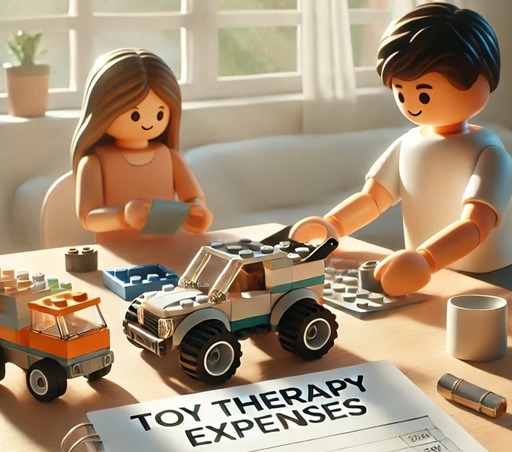


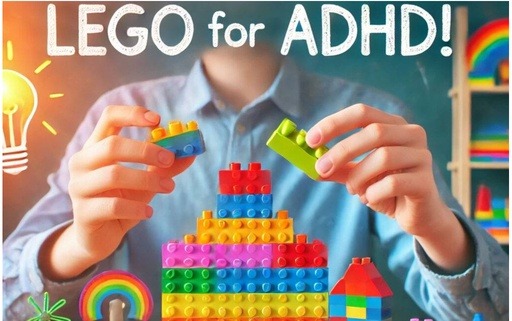

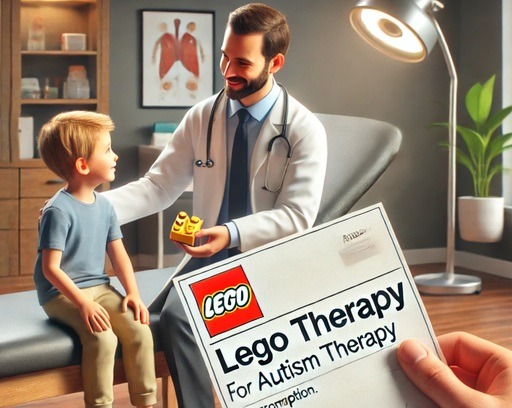

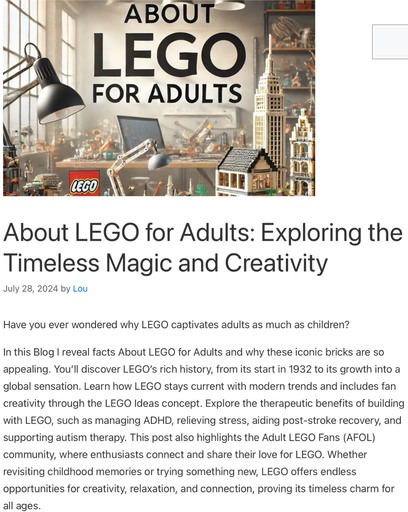
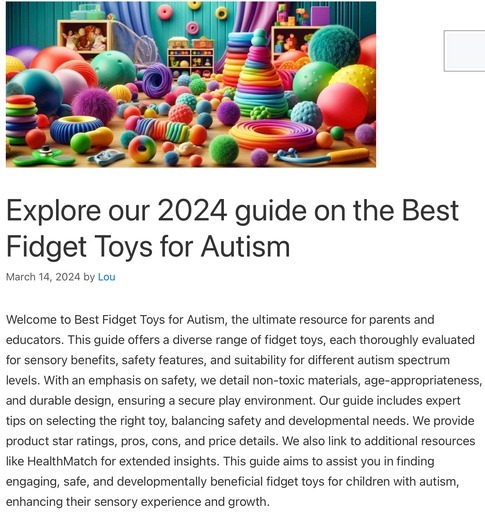
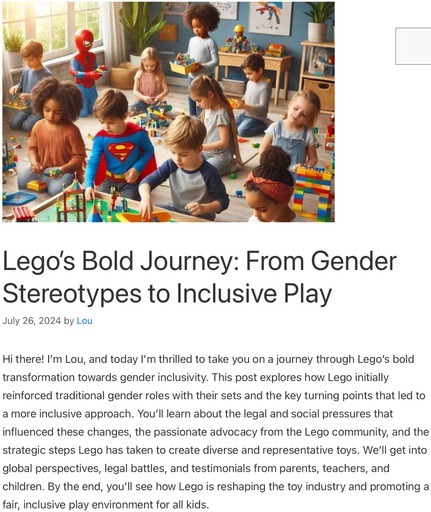

Thank you for sharing your personal and insightful experience with LEGO therapy. Your story highlights how a seemingly simple toy can have profound therapeutic benefits, from aiding in post-stroke recovery to supporting children with autism, ADHD and let’s not forget Stress relief ( what I need the most) It’s inspiring to see how LEGO therapy has positively impacted your family’s well-being and provided financial relief through tax deductions and insurance claims.
I particularly appreciate the practical advice on navigating insurance and tax benefits, as it’s often an overlooked aspect of managing therapeutic costs. Your suggestions for obtaining documentation and leveraging wellness programs are incredibly helpful for myself and others. I will definitely apply your suggestion in the post and save a few bucks. With these savings I’ll be able to purchase a few more LEGO sets that I’ve sad my eyes on and at the same time enjoying the health benefits that LEGO truly offers (stress free lol). What a great idea, love it!
Overall, your article effectively combines personal experience with actionable advice, making it a valuable resource for readers exploring alternative therapeutic options. Thanks again for sharing your journey and helping to shed light on the broader applications of LEGO therapy.
Hey Isaac! I’m so glad you found the Guide to Tax Deductions & Insurance Coverage for LEGO Therapeutic Toys helpful! It’s amazing how LEGO therapy can relieve stress (which we all could use, right?), and it’s awesome that you’re ready to save those bucks for more LEGO sets—win-win! Navigating tax deductions and insurance can be a maze, but it’s worth it when you’re getting therapeutic benefits for both you and the family. Thanks for the thoughtful comment, and happy building (stress-free, of course)
Lou.
Hello, The Guide to Tax Deductions & Insurance Coverage for LEGO Therapeutic Toys is an incredibly helpful and insightful resource! It shines a light on how these innovative therapeutic tools can be both beneficial for development and financially accessible. By offering clear guidance on potential tax deductions and insurance coverage, this guide makes it easier for families and individuals to take advantage of LEGO therapy, which can be a powerful aid for cognitive and motor skill development. It’s a fantastic initiative to support those in need of creative therapeutic solutions!
Hi Hamza,
Thank you so much for your thoughtful comment! I’m really glad you found the Guide to Tax Deductions & Insurance Coverage for LEGO Therapeutic Toys helpful and insightful. It’s great to hear that the guide resonates with those looking for both developmental and financial benefits through LEGO therapy.
LEGO therapy has proven to be an amazing tool for cognitive and motor skill development, and knowing that families and individuals can also make it financially accessible through tax deductions and insurance coverage is a huge win. I’m excited that this initiative could help more people embrace creative therapeutic solutions like LEGO.
I wanted to take a moment to express my gratitude for your insightful guide, “Guide to Tax Deductions & Insurance Coverage for LEGO Therapeutic Toys.” It is truly a valuable resource for anyone exploring LEGO therapy for conditions such as autism or ADHD. The practical steps you provided for claiming tax deductions and navigating insurance coverage are especially useful for those looking to maximize their benefits.
I also greatly appreciate your emphasis on the importance of maintaining detailed records and obtaining a doctor’s prescription—both of which are crucial when managing medical expenses.
It’s encouraging to see that several readers have already had success with their insurance and tax claims, and your personal testimonial adds even more credibility. Hearing firsthand experiences reassures others that these options are viable and genuinely helpful.
Thank you again for sharing such a comprehensive and beneficial guide.
Hi Herman,
Thank you so much for taking the time to leave such thoughtful feedback! I’m glad to hear that you found the “Guide to Tax Deductions & Insurance Coverage for LEGO Therapeutic Toys” helpful, especially in navigating the often complicated process of claiming tax deductions and securing insurance benefits. It’s great to know that the guide resonates with readers like yourself who are exploring LEGO therapy for conditions like autism and ADHD.
Maintaining detailed records and obtaining a doctor’s prescription are indeed crucial steps, and it’s encouraging to see that you found that emphasis helpful. It’s even more rewarding to see that several readers have already had success with their own insurance and tax claims, and I’m hopeful that this guide will continue to help others.
Your feedback and support mean a lot, and I truly appreciate your kind words. If you ever have more questions or would like to share your own experience with LEGO therapy, don’t hesitate to reach out!
Thanks again for your wonderful comment!
Best regards,
Lou
Wow, Guide To Tax Deductions & Insurance Coverage For LEGO Therapeutic Toys is truly a goldmine for anyone exploring LEGO therapy for conditions like autism or ADHD. The practical steps for claiming tax deductions and navigating insurance coverage are so valuable, especially if you’re trying to make the most of your benefits. I really appreciate how you emphasized the importance of keeping detailed records and getting a doctor’s prescription—it’s crucial when managing medical expenses.
I see in the comments that a couple of readers have already had success with their insurance and tax claims, and your own testimonial adds so much value. It’s great to hear firsthand experiences and know that these options are really helping others. Thank you again for sharing this insightful guide, Lou!
Hi Vlad,
Thanks for your comment! I’m glad you found the LEGO Therapy Tax Deductions & Insurance Guide practical and informative. The steps on keeping detailed records and obtaining a doctor’s prescription are definitely key in making the most of these benefits.
It’s great to see success stories from readers like Dr. Cyprian and Jocelyn, who’ve already navigated the process with positive results. Hearing about their real-life experiences adds a valuable perspective.
Thanks again for your thoughtful feedback!
Lou
Wow! I wish I knew there were benefits for LEGO Toy Therapy and tax benefits. I could have used them. Moving forward I’ll definitely check out my benefits and use them as my child has Autusm and this useful resource will definitely lighten the load out of my pocket. Thanks for this post Lou! You continue to surprise me with your informative guides.
Kyle
Hi Kyle,
Thanks for your thoughtful comment! I’m really glad to hear that you found the post helpful. LEGO Toy Therapy can truly make a difference, especially when navigating the challenges that come with autism. It’s great that you’re planning to check out your benefits now—hopefully, it lightens the financial load for you moving forward. Every bit of support counts, and the combination of tax benefits and insurance coverage can really help.
Feel free to reach out if you have any more questions, and I’m happy to continue sharing these kinds of resources! Best of luck as you explore your options.
Lou
hi! just wanted to respond to your post on Guide To Tax Deductions & Insurance Coverage For LEGO Therapeutic Toys. I have personally used some of these benefits through my employers benefits while it only covers us for $100 this year, once I reach 5 years at my current employer it upgrades to $200 then more after 10 years of employment. I recommend reaching out to your HR or reviewing your work benefits. thanks for this post, I’ll definitely check out my insurance benefits and taxable credits in this regard.
Great post lou! it’s very insightful and well resourced.
Jocelyn.
Hi Jocelyn,
Thanks for sharing your experience with using employer benefits! It’s great to hear that you’ve already tapped into some of these resources, and it’s especially helpful to know how benefits increase with longer employment. Your recommendation to reach out to HR and review work benefits is spot on—it’s often overlooked how much employers can offer in wellness spending, even if it’s a small amount initially.
I’m really glad the post gave you some additional insights to explore insurance benefits and tax credits. Be sure to take full advantage of both as you grow in your role and as your benefits expand over time!
If you have any other questions down the road or want to share more of your experience, feel free to reach out.
Lou
This article is amazing! I had no idea LEGO therapy could be such a powerful tool for conditions like autism and ADHD. The way you explain the process of getting tax deductions and insurance coverage is so clear and helpful! I’m curious, have you ever heard of people using other types of toy therapy and getting similar benefits? Or maybe LEGO therapy works better due to its unique structure? It would be great to hear more success stories!
Thanks for sharing such valuable content!
GJ
Hi Gabriel,
Thank you for your comment! I’m glad you found the article helpful. Regarding success stories, Dr. Cyprain actually shared his experience in a previous comment here. He successfully claimed LEGO therapy through both tax relief and insurance benefits, which has made a real difference for his family. It’s great to see how LEGO therapy has such a positive impact.
Thanks again for engaging, and feel free to share your thoughts if you explore this further.
Lou
This post is incredibly informative and helpful, providing a step-by-step guide to claiming tax deductions and insurance coverage for LEGO therapeutic toys. The personal experience shared by the author adds a relatable touch, and the detailed explanations of the rules and requirements for both US and Canadian taxpayers are invaluable.
I found the section on navigating insurance coverage and employer wellness benefits to be particularly useful, as it highlights the importance of reviewing policies and confirming eligibility for reimbursement.
I’d love to continue the discussion by exploring the following questions:
1. What are some common challenges or obstacles that people face when trying to claim tax deductions or insurance coverage for LEGO therapy?
2. How can we raise awareness about the therapeutic benefits of LEGO toys and advocate for greater recognition and support from insurance providers and tax authorities?
I’m excited to hear others’ thoughts and experiences on these topics, and I’m grateful to the author for creating a space for this informative conversation. Let’s continue to explore the potential of LEGO therapy and work together to make it more accessible and affordable for those who need it!
Thank you so much for your thoughtful and insightful comment, Cyril! I’m thrilled to hear that you found the post helpful, especially the sections on navigating insurance coverage and wellness benefits. These areas can sometimes feel overwhelming, so it’s great to know they provided clarity.
To your questions:
1. Common Challenges for Tax Deductions and Insurance Coverage: Many people find that the biggest hurdle is gathering the necessary documentation, like doctor’s notes or receipts, to support their claims. In some cases, there’s also confusion about whether LEGO therapy qualifies as a medical expense under certain insurance policies or tax codes. Ensuring that you have a clear treatment plan and prescription from a healthcare professional can go a long way toward overcoming these obstacles.
2. Raising Awareness About LEGO Therapy: Advocacy is key, and sharing success stories—whether through social media, blogs, or community discussions—can help spread awareness. Collaborating with therapists, doctors, and educators to highlight the therapeutic benefits of LEGO is also crucial. In the long run, greater recognition from tax authorities and insurance providers could help make LEGO therapy more accessible and affordable for those who need it.
I really appreciate your contributions to the conversation and encourage others to share their experiences and thoughts as well. Let’s keep the dialogue going and continue to advocate for greater support and recognition for LEGO therapy!
Feel free to reach out anytime, and thanks again for being part of this important discussion
Lego Lou
I had no idea that LEGO bricks could be used for therapeutic purposes and that there might be potential tax benefits involved. It’s fascinating to see how something as fun as building with LEGO can have real-world applications. I’m curious, have there been any specific case studies or examples where people successfully claimed these deductions?
Hi Andy,
Thanks for your comment! I’m glad to hear that you found the idea of using LEGO for therapy and the associated tax benefits intriguing. In fact, my own personal testimonial in the post outlines how I’ve successfully claimed insurance coverage for LEGO therapy, including the requirements involved. As referenced in the post, Dr. Cyprian shared his experience in a previous comment about how he also navigated tax deductions and insurance coverage for LEGO therapy. His personal story demonstrates the practical side of claiming these benefits.
Regarding your question, the examples I’ve provided—such as those from Dr. Cyprian—serve as real-life testimonials showing the feasibility of these claims. Additionally, many therapists and healthcare professionals are beginning to see the therapeutic potential of LEGO, especially in cases involving autism, ADHD, and even post-stroke recovery, which makes it easier to include these expenses under medical deductions or insurance coverage.
If you’re looking to explore this for yourself, I would recommend gathering receipts, securing a doctor’s recommendation, and checking your employer’s wellness benefits for possible reimbursements.
I hope this helps, best of luck.
Lou
This is really fascinating and a real eye opener. Legos were formed in 1949 and when I was a kid of about 10 years old (1962) I got a set of Lego building blocks and a set of Lincoln logs for Christmas. I really enjoyed both but because we moved around so much, they became a memory. Your article on the therapeutic aspect of Lego is amazing. Your informative guide on tax related and insurance claims is very informative and helpful for a guy like me that could benefit by using my money wisely with your guide. I will definitely review my policy and work benefits and apply some of these. I Could use the extra savings right now as things are tight. Thanks Lou!
Hi Walter,
Thank you so much for sharing your personal story about your childhood LEGO set and Lincoln logs—it’s amazing how those childhood memories stick with us, even through all the moves! I’m really glad the article resonated with you and that you found the information on tax-related and insurance claims helpful.
It’s great to hear that you’re considering reviewing your policy and work benefits; those extra savings can really add up, especially when things are tight. I’m all about helping people make the most of the resources they have, and it’s encouraging to know that the guide can offer some practical solutions for your situation.
If you ever need any more insights or have questions as you navigate the process, feel free to reach out! Thanks again for your thoughtful comment, and I’m wishing you all the best as you explore these benefits.
Take care,
Lou
Hi Lou.
I’ve successfully claimed LEGO therapy as a medical expense through both tax relief and private insurance benefits. Though the paperwork can seem intimidating, having receipts and a recommendation from a therapist can go a long way in getting reimbursements. And for those considering this, I’d strongly encourage speaking with a doctor to get LEGO therapy recognized as part of your or your child’s treatment plan. A doctor’s note could be all it takes to make these expenses deductible or covered by insurance.
To anyone else going through similar challenges, don’t hesitate to explore the financial benefits available through tax deductions and insurance coverage. I’ve done it, and it’s made a world of difference for my family’s well-being.
Hi Dr. Cyprain,
Thank you so much for sharing your personal experience! It’s fantastic to hear that you’ve successfully navigated both tax relief and insurance benefits for LEGO therapy—it really shows that while the paperwork can seem overwhelming, it’s absolutely worth the effort. Your advice about getting a doctor’s recommendation is invaluable, and I’m sure it will resonate with others considering this approach for themselves or their children.
I couldn’t agree more with your encouragement to explore these financial benefits. It’s a relief to know that options like tax deductions and insurance coverage can truly make a difference in both therapy and the well-being of families. I really appreciate your comment and insights.
This is such a unique perspective on using LEGO bricks for therapy and tax deductions! As someone who’s been in the health industry for over 30 years, I can totally see the therapeutic benefits of using toys like LEGO for stress relief and focus. It’s interesting how something so playful can also serve as a tool for mindfulness, especially in managing work-related stress. I love the idea that it could even qualify for a tax deduction when used for professional development—what a creative angle! Great article, and thanks for bringing this fun and practical topic to light!
Thank you so much for your thoughtful comment, Steve! It’s great to hear your perspective, especially with your extensive experience in the health industry. I completely agree—LEGO bricks are such an unassuming yet powerful tool for stress relief and mindfulness. Their versatility in managing work-related stress and improving focus really makes them stand out as more than just a toy. The fact that they can also qualify for a tax deduction when used as part of professional or therapeutic development is indeed a unique and practical angle! I’m glad you enjoyed the article, and I hope it sparks even more conversations about how we can creatively use tools like LEGO for both mental health and financial benefits. Feel free to share any of your insights or experiences with using therapeutic tools like LEGO!
Thanks again for your support, Steve!
Lego Lou